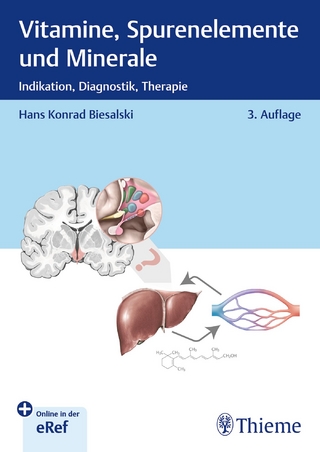
Vitamin E in Human Health
Springer International Publishing (Verlag)
978-3-030-05314-7 (ISBN)
Given this level of new evidence which has emerged over the recent years, a book on vitamin E will put into perspective the concerns which have been raised on vitamin E and which resulted in a misinformation and confusion of the public regarding the importance of vitamin E for human health. This book will reemphasize that Vitamin E is clearly required for human health and its inadequacy leads to increased risk of a variety of diseases. In addition new data of non-communicable diseases (NCD) dependent on vitamin E status show that a lifetime of low intake increases risks of development, severity and complications of NCDs. This text will put the vitamin E case into an up-to-date, science based, applicable real-life perspective and offer pragmatic solutions for its safe and personalized use beyond the various methodological and statistical controversies. The purpose of this book is also to raise awareness not only in the nutrition and medical community, but also in the public media that there are a number of health conditions where an increased intake of vitamin E can be of potential importance. Further this review shouldalso stimulate funding organizations and agencies to increase their support for vitamin E research in order to facilitate the further exploration of the safe and efficacious use of this essential micronutrient.
Peter WeberInstitute of Biological Chemistry and NutritionUniversity of HohenheimStuttgart, Germany Marc BirringerDepartment of Nutritional, Food and Consumer SciencesFulda University of Applied SciencesFulda, Germany Jeffrey B. Blumberg,PhD, Jean Mayer USDA Human Nutrition Research Center on AgingFriedman School of Nutrition Science and PolicyTufts University Manfred Eggersdorfer DSM Nutritional ProductsKaiseraugst, Switzerland Jan FrankInstitute of Biological Chemistry and NutritionUniversity of HohenheimStuttgart, Germany
Introduction.- History of Vitamin E Research.- Antioxidative Activity of Vitamin E.- Bioavailability and Metabolism of Vitamin E.- Occurrence and Bioactivities of Minor Vitamin E Derivatives.- Bioactivity of Vitamin E Long-Chain Metabolites.- Gene-regulatory Activity of Vitamin E.- Metabolomic Approaches in Vitamin E Research.- The Tocopherol Transfer Protein: Regulator of Vitamin E Status.- The Role of Lipid Rafts in Mediating the Anticancer Effects of y-Tocotrienol.- Interaction between Vitamin E and Polyunsaturated Fatty Acids.- The Challenge of Defining Daily Intake Recommendations: Vitamin E and Polyunsaturated Fatty Acids.- Vitamin E Intake and Serum Levels in the General Population: a Global Perspective.- Vitamin E Serum Levels and the Challenge to Correct for Lipids: Accounting for the Usual Double Correction for Variance shared by Total Cholesterol and Fasting Triglycerides Reveals New Insights into the Association with the One Carbon Pathway.- Stability of Vitamin E in Foods.- Vitamin E and Mortality: A Critical Perspective of the Conflicting Meta-Analysis Outcomes.- Vitamin E: Drug Interactions.- Vitamin E: Interactions with Vitamin K and other Bioactive Compounds.- Clinical Cardiovascular Disease Trials: The Vitamin E Case.- Haptoglobin Genotype and a Promising Pharmacogenomic Approach to Prevent Diabetic Atherothrombosis with Vitamin E Supplementation.- Vitamin E and Metabolic Syndrome.- Vitamin E in nonalcoholic Fatty Liver Disease.- The Role of Vitamin E in Aging and Alzheimer's Disease.- The Impact of Vitamin E Isoforms on Asthma and Allergy.- Vitamin E, Immune Function, and Protection Against Infection.- Vitamin E and Air Pollution.- The Role of Vitamin E in Pregnancy.- Vitamin E and Health Care Costs: Models to Assess the Impact.- Do Consumers Care about Micronutrients? A Perspective on the Possible Role of Vitamin E in the Dietary Choices of Consumers.- Addressing Key Knowledge Gaps in Nutrition and the Impact of Funding Priorities in Human Nutrition.
| Erscheinungsdatum | 13.04.2019 |
|---|---|
| Reihe/Serie | Nutrition and Health |
| Zusatzinfo | XXXIX, 467 p. 103 illus., 58 illus. in color. |
| Verlagsort | Cham |
| Sprache | englisch |
| Maße | 178 x 254 mm |
| Gewicht | 1522 g |
| Themenwelt | Medizin / Pharmazie ► Gesundheitsfachberufe ► Diätassistenz / Ernährungsberatung |
| Medizin / Pharmazie ► Medizinische Fachgebiete | |
| Naturwissenschaften ► Biologie ► Biochemie | |
| Technik ► Lebensmitteltechnologie | |
| Schlagworte | Apha-tocopherol Transfer Protein • Vitamin E and Drug Interactions • Vitamin E and Hormones • Vitamin E and Insulin Sensitivity • Vitamin E and Obesity • Vitamin E and Pregnancy • Vitamin E in Fetal Development • Vitamin E in the Brain |
| ISBN-10 | 3-030-05314-8 / 3030053148 |
| ISBN-13 | 978-3-030-05314-7 / 9783030053147 |
| Zustand | Neuware |
| Informationen gemäß Produktsicherheitsverordnung (GPSR) | |
| Haben Sie eine Frage zum Produkt? |
aus dem Bereich


